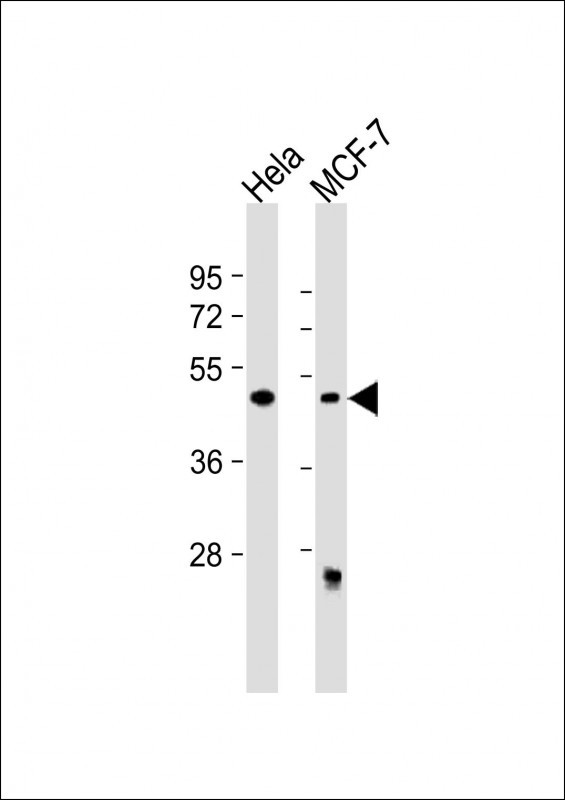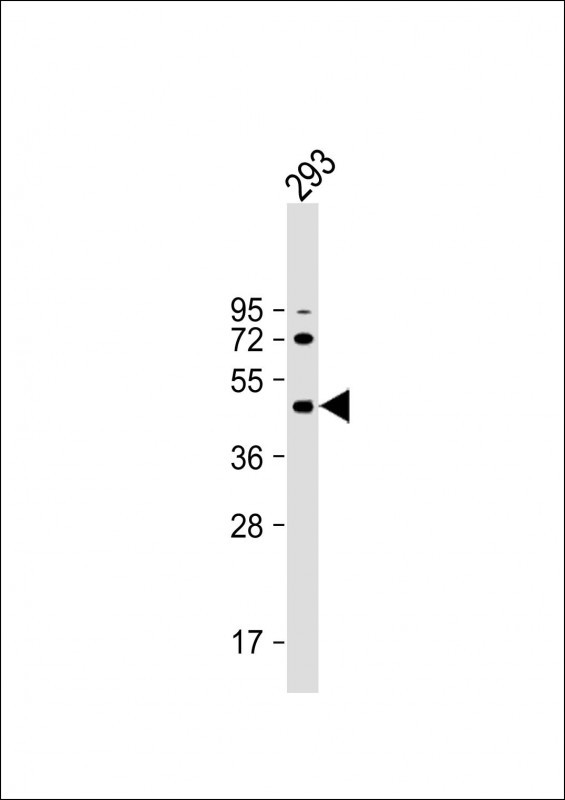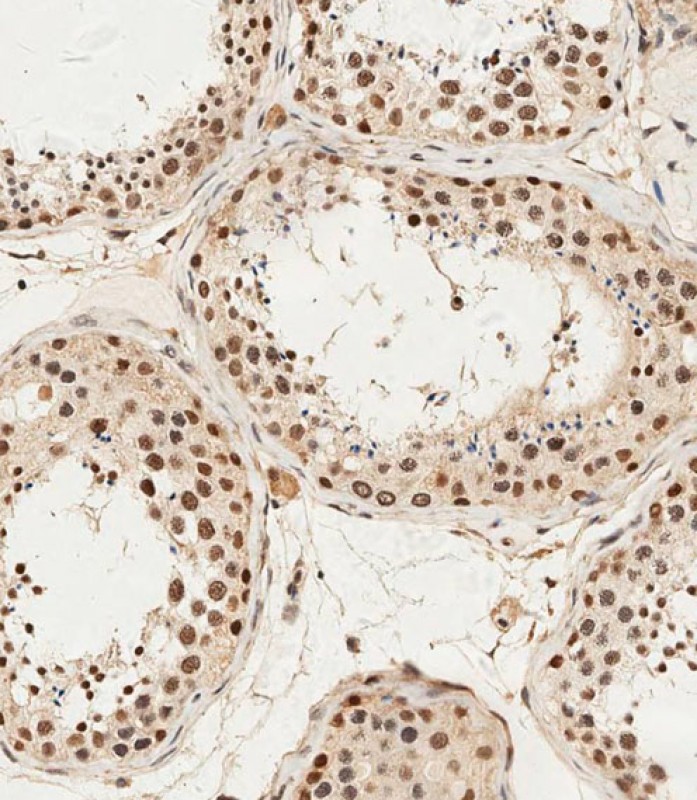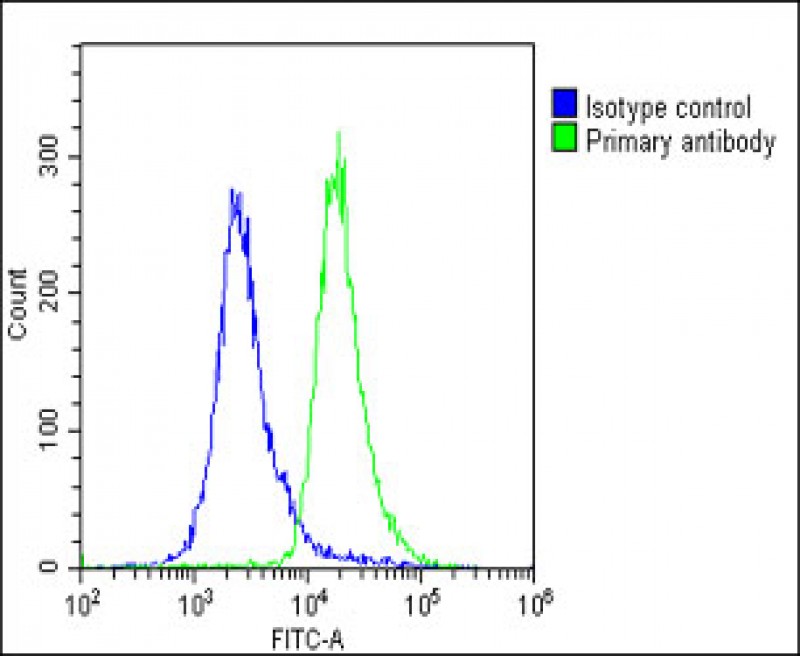ALKBH5 Antibody (Center)
Affinity Purified Rabbit Polyclonal Antibody (Pab)
- SPECIFICATION
- CITATIONS
- PROTOCOLS
- BACKGROUND

Application
| WB, FC, IHC-P, E |
|---|---|
| Primary Accession | Q6P6C2 |
| Other Accession | D3ZKD3, Q3TSG4, E1BH29, NP_060228.3 |
| Reactivity | Human |
| Predicted | Bovine, Mouse, Rat |
| Host | Rabbit |
| Clonality | Polyclonal |
| Isotype | Rabbit IgG |
| Calculated MW | 44256 Da |
| Antigen Region | 302-330 aa |
| Gene ID | 54890 |
|---|---|
| Other Names | RNA demethylase ALKBH5, 11411-, Alkylated DNA repair protein alkB homolog 5, Alpha-ketoglutarate-dependent dioxygenase alkB homolog 5, ALKBH5, ABH5, OFOXD1 |
| Target/Specificity | This ALKBH5 antibody is generated from rabbits immunized with a KLH conjugated synthetic peptide between 302-330 amino acids from the Central region of human ALKBH5. |
| Dilution | WB~~1:2000 FC~~1:25 IHC-P~~1:100 E~~Use at an assay dependent concentration. |
| Format | Purified polyclonal antibody supplied in PBS with 0.09% (W/V) sodium azide. This antibody is purified through a protein A column, followed by peptide affinity purification. |
| Storage | Maintain refrigerated at 2-8°C for up to 2 weeks. For long term storage store at -20°C in small aliquots to prevent freeze-thaw cycles. |
| Precautions | ALKBH5 Antibody (Center) is for research use only and not for use in diagnostic or therapeutic procedures. |
| Name | ALKBH5 {ECO:0000303|PubMed:23177736, ECO:0000312|HGNC:HGNC:25996} |
|---|---|
| Function | Dioxygenase that specifically demethylates N(6)- methyladenosine (m6A) RNA, the most prevalent internal modification of messenger RNA (mRNA) in higher eukaryotes (PubMed:23177736, PubMed:24489119, PubMed:24616105, PubMed:24778178, PubMed:34048572, PubMed:36944332, PubMed:37257451, PubMed:37369679). Demethylates RNA by oxidative demethylation, which requires molecular oxygen, alpha- ketoglutarate and iron (PubMed:21264265, PubMed:23177736, PubMed:24489119, PubMed:24616105, PubMed:24778178). Demethylation of m6A mRNA affects mRNA processing, translation and export (PubMed:23177736, PubMed:34048572, PubMed:36944332, PubMed:37257451). Can also demethylate N(6)-methyladenosine in single-stranded DNA (in vitro) (PubMed:24616105). Required for the late meiotic and haploid phases of spermatogenesis by mediating m6A demethylation in spermatocytes and round spermatids: m6A demethylation of target transcripts is required for correct splicing and the production of longer 3'-UTR mRNAs in male germ cells (By similarity). Involved in paraspeckle assembly, a nuclear membraneless organelle, by undergoing liquid-liquid phase separation (PubMed:37369679, PubMed:37474102). Paraspeckle assembly is coupled with m6A demethylation of RNAs, such as NEAT1 non-coding RNA (PubMed:37474102). Also acts as a negative regulator of T-cell development: inhibits gamma-delta T-cell proliferation via demethylation of JAG1 and NOTCH2 transcripts (By similarity). Inhibits regulatory T-cell (Treg) recruitment by mediating demethylation and destabilization of CCL28 mRNAs (By similarity). |
| Cellular Location | Nucleus speckle Note=Promotes formation and localizes to paraspeckles, a nuclear membraneless organelle. |
| Tissue Location | Widely expressed, with highest expression in lung, followed by testis, pancreas, spleen and ovary |

Thousands of laboratories across the world have published research that depended on the performance of antibodies from Abcepta to advance their research. Check out links to articles that cite our products in major peer-reviewed journals, organized by research category.
info@abcepta.com, and receive a free "I Love Antibodies" mug.
Provided below are standard protocols that you may find useful for product applications.
Background
Probable dioxygenase that requires molecular oxygen, alpha-ketoglutarate and iron (By similarity).
References
Olsen, J.V., et al. Cell 127(3):635-648(2006)
Bi, W., et al. Genome Res. 12(5):713-728(2002)
If you have used an Abcepta product and would like to share how it has performed, please click on the "Submit Review" button and provide the requested information. Our staff will examine and post your review and contact you if needed.
If you have any additional inquiries please email technical services at tech@abcepta.com.













 Foundational characteristics of cancer include proliferation, angiogenesis, migration, evasion of apoptosis, and cellular immortality. Find key markers for these cellular processes and antibodies to detect them.
Foundational characteristics of cancer include proliferation, angiogenesis, migration, evasion of apoptosis, and cellular immortality. Find key markers for these cellular processes and antibodies to detect them. The SUMOplot™ Analysis Program predicts and scores sumoylation sites in your protein. SUMOylation is a post-translational modification involved in various cellular processes, such as nuclear-cytosolic transport, transcriptional regulation, apoptosis, protein stability, response to stress, and progression through the cell cycle.
The SUMOplot™ Analysis Program predicts and scores sumoylation sites in your protein. SUMOylation is a post-translational modification involved in various cellular processes, such as nuclear-cytosolic transport, transcriptional regulation, apoptosis, protein stability, response to stress, and progression through the cell cycle. The Autophagy Receptor Motif Plotter predicts and scores autophagy receptor binding sites in your protein. Identifying proteins connected to this pathway is critical to understanding the role of autophagy in physiological as well as pathological processes such as development, differentiation, neurodegenerative diseases, stress, infection, and cancer.
The Autophagy Receptor Motif Plotter predicts and scores autophagy receptor binding sites in your protein. Identifying proteins connected to this pathway is critical to understanding the role of autophagy in physiological as well as pathological processes such as development, differentiation, neurodegenerative diseases, stress, infection, and cancer.





